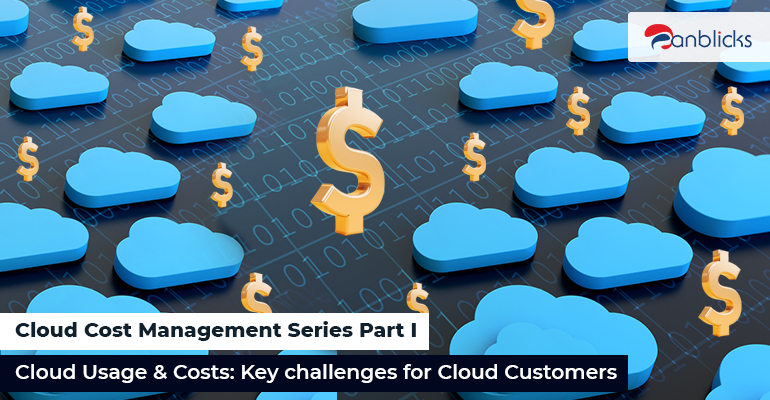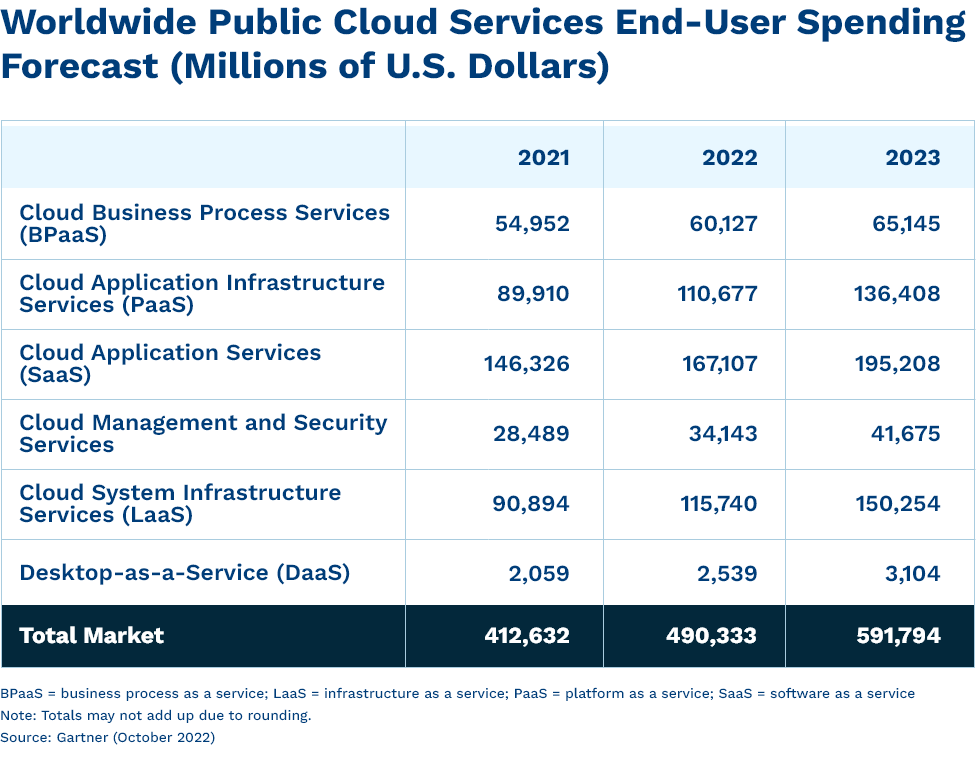
Cloud Cost Management Series Part I – Cloud Usage & Costs: Key challenges for Cloud Customers
In the past few decades, the cloud has provided organizations with greater flexibility, agility, and scalability, enabling them to respond more quickly to changing business needs and stay ahead of the competition.
According to the latest forecast from Gartner worldwide, end-user spending on public cloud services is forecast to grow 20.7% to a total of$591.8 billion in 2023, up from $490.3 billion in 2022. This is higher than the 18.8% growth forecast for 2022.

Why customers are Moving to Cloud Technologies
- Cost savings: Cloud services can be more cost-effective than traditional on-premises IT solutions, as customers only pay for what they use and don’t have to invest in expensive hardware and infrastructure.
- Scalability: Cloud services can be scaled up or down to meet changing business needs without significant additional hardware and software investments.
- Innovation: Cloud providers offer access to the latest technologies and innovations, allowing customers to adopt new capabilities and stay ahead of the competition quickly.
- Security: Many cloud providers invest heavily in security measures to protect customer data and ensure compliance with industry regulations.
Major Challenges faced by Cloud Customers
Cloud computing has revolutionized how businesses operate and store data, providing cost-effective solutions, flexibility, and scalability. However, despite its advantages, cloud customers face several key challenges to leverage the benefits of cloud computing fully.
Based on our experience and research, we have found some key challenges for cloud customers.
1. Improper Provisioning
Compared to on-prem infrastructure, cloud providers generally offer a variety of services and configurations for similar deployment architecture. With this variety of options available, customers often need help with improper provisioning. Some of the key issues are:
- Overprovisioning – Allocating more resources than necessary, leading to increased costs.
- Under provisioning – Allocating too few resources, leading to poor performance and potential downtime.
- Improper security configuration – Failing to properly secure cloud resources, potentially leading to data breaches or other security incidents.
- Lack of redundancy – Not properly configuring redundancy for critical systems, leading to increased risk of downtime or data loss.
- Inadequate monitoring and management – Neglecting to monitor and manage cloud resources, resulting in poor performance and resource utilization.
2. Unused or under-utilized Resources
Utilization of cloud resources happens more often with cloud customers even though they have provisioned the infrastructure by utilizing the right cloud services and configurations. This leads to paying charges for something which needs to be utilized. Here are some of the potential hotspots for unutilized cloud resources based on our experience:
- Development and testing environments
- Old or inactive projects
- Over-provisioned instances
- Unmonitored auto-scaling groups
- Stale or infrequently used data archives
- Unoptimized resource allocation
- Idling virtual machines
3. Lack of visibility & control over the usage and costs
We at Anblicks are engaged with small, medium, and large enterprises using one or more cloud providers for hosting their IT landscape. With our experience, we found that every enterprise follows its controlling structure for utilizing cloud resources. Most mid and large enterprises allow individual teams to manage their cloud resources. Due to a lack of visibility, most customers find it challenging to visualize and control their cloud usage and costs. Some of the key reasons for such challenges are
- Uncontrolled usage of cloud services
- Shadow IT practices leading to unexpected costs
- Inaccurate cost tracking and billing
- Difficulty in holistic monitoring and managing cloud usage in multi-cloud environments
- Limited transparency into resource utilization and cost breakdowns
- Need to include the right cloud cost intelligence tooling for monitoring and optimizing cloud utilization, cost organizations
Related Blog: Why is it Better to Migrate On-Premises Data to Cloud
4. Spend Forecasting
This helps organizations plan their budgets and make informed decisions about their cloud investments. Forecasting involves:
- Analyzing past usage patterns and projecting them into the future
- Considering factors such as anticipated growth
- Changes in usage
- Pricing changes from cloud providers
Most cloud customers need help to forecast their cloud spend accurately. To accurately forecast cloud, spend, organizations need the right cloud cost intelligence tooling to regularly monitor and analyze their cloud usage and cost and update their projections as needed.
5. Billing complexity to manage multiple cloud accounts with various vendors
Managing multiple cloud accounts with various vendors can create billing complexity for organizations. The challenge arises from tracking and managing each account and vendor’s costs and ensuring that charges are properly allocated to the correct departments or projects. This can require significant time and effort and may lead to errors and discrepancies in billing.
Organizations can overcome this complexity by using tools and platforms that provide a centralized view of their cloud spending, automate cost tracking and allocation, and provide detailed reporting and analysis capabilities. By doing so, they can gain greater visibility into their cloud spend, reduce manual effort and errors, and make more informed decisions about their cloud investments.
Based on the above challenges, experience, and customer requirements, we have built a solution and developed one tool for cloud costs to optimize cloud spending in a multi-cloud, multi-vendor, and multi-billing world.
Stay tuned for Cloud Cost Management Series – Part II blog on centralized, consolidated cloud costs tool…
Make your cloud costs work for you

8+ years of dynamic & result-oriented professional experience in Software/Application Development. He is interested in learning and exploring trending technologies and tools. He is currently working as a senior software engineer at Anblicks. In his time, he likes to watch movies/series, spend time with family/friends and travel.

